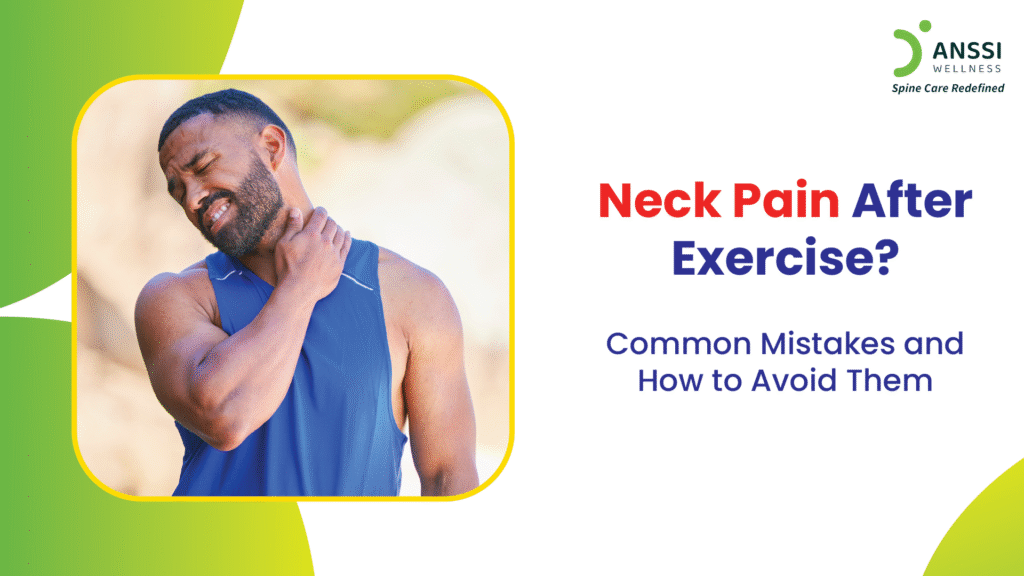Exercise is one of the best things you can do for your body. It strengthens muscles, boosts energy, and improves overall well-being. But what if your workouts leave you with unwanted side effects like neck pain? For many fitness enthusiasts, neck discomfort after exercise is a common and frustrating issue. Instead of reaping the benefits of physical activity, they end up with stiffness, soreness, or even radiating pain in the upper body.
The good news? Neck pain after exercise is often preventable. By identifying common mistakes and adopting healthier workout practices, you can protect your neck and enjoy safe, pain-free fitness.
Common Mistakes That Cause Neck Pain
Let’s explore the frequent workout mistakes that trigger neck pain:
1. Poor Posture During Workouts
Rounding your shoulders, arching your back, or jutting your head forward while lifting weights or cycling can compress the cervical spine. This repeated strain can cause soreness or long-term neck problems.
2. Incorrect Breathing Techniques
Holding your breath while lifting weights (the Valsalva maneuver) or straining during reps can tighten neck muscles unnecessarily. Proper breathing keeps muscles oxygenated and relaxed.
3. Lifting Excessive Weight
Using heavier weights than your body can handle often leads to compensatory movements, such as tensing the neck and shoulders. This mistake is especially common in beginners eager to progress quickly.
4. Skipping Warm-ups and Stretches
Jumping straight into an intense workout without preparing your muscles increases injury risk. Similarly, neglecting cool-down stretches prevents your muscles from releasing tension built up during exercise.
5. Excessive Screen Use During Workouts
Many people glance at their phones for music, messages, or videos during exercise. Constantly tilting your head downwards strains the neck and disrupts posture, leading to post-workout pain.
6. Pre-existing Conditions
If you have cervical spondylosis or a slipped disc, even mild exercise errors may aggravate pain.
How to Avoid Neck Pain
The key to preventing exercise-related neck pain is mindfulness and consistency. Here are practical strategies:
Maintain Proper Posture
Keep your head aligned with your spine during workouts. Engage your core, relax your shoulders, and avoid slouching. For cycling, adjust your handlebars to a comfortable height to prevent excessive neck extension.
Focus on Controlled Movements
Avoid jerky or rushed motions. Slow, deliberate repetitions ensure that your muscles, not momentum, are doing the work, reducing unnecessary strain on the neck.
Use Appropriate Weights
Choose weights that allow you to maintain correct form throughout your sets. Progress gradually rather than pushing for heavy loads too quickly.
Prioritise Warm-ups and Cool-downs
Spend at least 5-10 minutes warming up with light cardio and mobility drills. After exercising, stretch your neck, shoulders, and back to release tension and improve flexibility.
Strengthen Supporting Muscles
Incorporate exercises that build strength in the upper back and shoulders, such as rows or scapular retractions. Stronger supporting muscles help maintain good posture and reduce neck strain.
Minimise Screen Time During Workouts
If possible, set your playlist in advance or use voice controls to avoid constantly looking down at your phone. This small change can protect your neck significantly.
When to Seek Help
Occasional mild soreness may resolve with rest, stretching, and improved technique. However, you should seek professional help if:
- Pain persists for more than a few days despite rest.
- You experience tingling, numbness, or radiating pain in the arms.
- Neck movement becomes severely restricted.
In such cases, consulting a spine care expert is essential. Non-surgical treatments like Physiotherapy and Spinal Decompression can relieve pressure on spinal structures, improve mobility, and support long-term recovery without invasive procedures. Posture correction and ergonomic guidance are also effective solutions for managing chronic exercise-related neck pain.
About ANSSI:
ANSSI Wellness focuses on improving the quality of life for patients suffering from spinal issues, aiming to provide relief where other conventional treatments have failed. Through advanced Non-Surgical Spinal Decompression Treatment, ANSSI is committed to helping patients avoid surgery and recover in a safe, effective, and compassionate environment.
Connect with ANSSI Wellness on LinkedIn, Instagram, and Facebook for expert guidance.




